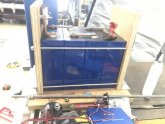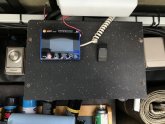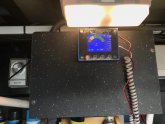View attachment 10348View attachment 10349View attachment 10352
Love those 3D printed modular cases!
Still, I built a very simple battery box which is 12"x8" x 11" h) with 3/4" plywood, 1/4" threaded rod, 1" x 1" aluminum angle and a cutup cutting board for the lid from Target. The main load relay Gigavac and charge SSR are contained within the box. The carling switch is manual relay kill, so I can put the battery in sleep mode (<1.0 amp flow).
I used threaded rod to retain the shunt and mount the relay, also. I connected to the battery to the shunt and from the fuse to the contactor relay with bent up busbar copper. This was about $20 in hardware / parts plus scrap plywood.
Mounting feet are aluminum angle. I placed 3/16" rubber pad which I cut to fit to reduce a bit of vibration against the framerail. I made a template and drilled the framerail and install thick wall rivnuts so I could bolt it in place.
Lots of ways to do this.
Hope this might help someone.
BTW - If this post is not sufficiently relevant, I can extract and post elsewhere.









